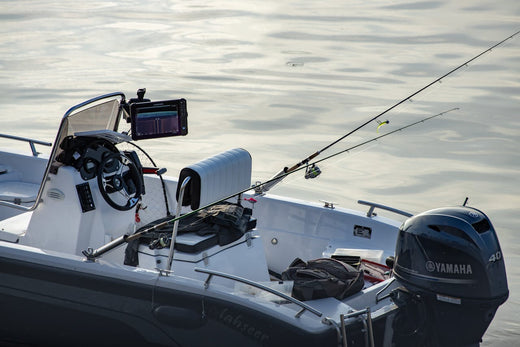Your Cart is Empty
ORDERS OVER $99 UNLOCK FREE* SHIPPING
Menu
-
- Home
- Archery
- Automotive/RV
- Boating
- Camping
- Fishing
- Hunting
- Outdoor
- Shooting
- Trailering
- Watersports
- Brands
-
- (208) 590-7477
- Login

ORDERS OVER $99 UNLOCK FREE* SHIPPING

Trolling Motor Maintenance: Your Essential Checklist
8 min read
As an avid angler, you rely on your trolling motor to get you to the best fishing spots and help you reel in the big ones. But without regular maintenance, your motor can quickly become unreliable and even break down, leaving you stranded on the water. By following this crucial checklist, you'll be able to identify and address potential issues before they become major problems, ensuring your trolling motor runs smoothly and efficiently all season long.
Key Takeaways:
- Regular Cleaning: Regularly cleaning your trolling motor is crucial to maintain its performance and extend its lifespan. Make it a habit to clean the motor after every use, paying attention to the propeller, shaft, and housing.
- Propeller Inspection: Inspect your propeller regularly for signs of damage, such as dings, dents, or corrosion. A damaged propeller can reduce the motor's efficiency and cause vibration, making it important to replace it if necessary.
- Battery Maintenance: Proper battery maintenance is vital to ensure your trolling motor functions correctly. Check your batteries regularly for signs of wear, corrosion, or damage, and maintain the recommended water levels.
- Corrosion Protection: Corrosion can significantly reduce the lifespan of your trolling motor. Apply a corrosion inhibitor to the metal components, and consider using a corrosion-resistant coating on the propeller and shaft.
- Scheduled Servicing: Schedule regular servicing for your trolling motor to identify and address any potential issues before they become major problems. This can include tasks such as lubricating the bearings, checking the electrical connections, and inspecting the motor's internal components.
Understanding Trolling Motor Types
To ensure proper maintenance, you need to understand the different types of trolling motors available in the market. Here's a breakdown of the main types:
- Freshwater Trolling Motors
- Saltwater Trolling Motors
- Bow Mount Trolling Motors
- Transom Mount Trolling Motors
- Other specialized types (e.g., kayak, pontoon, etc.)
Assume that each type has its unique features, advantages, and maintenance requirements.
| Type | Description |
|---|---|
| Freshwater | Designed for use in freshwater lakes, rivers, and streams |
| Saltwater | Designed for use in saltwater environments, such as oceans and seas |
| Bow Mount | Mounted on the bow (front) of the boat, providing more control and maneuverability |
| Transom Mount | Mounted on the transom (back) of the boat, providing more power and stability |
Freshwater Trolling Motors
Trolling through calm freshwater lakes and rivers requires a motor that can handle the serene environment. Freshwater trolling motors are designed to provide a smooth and quiet ride, making them ideal for fishing and cruising.
Saltwater Trolling Motors
Understanding the harsh conditions of saltwater environments, saltwater trolling motors are built to withstand corrosion and provide more power to combat strong currents and winds.
Motors designed for saltwater use typically feature specialized materials and coatings to resist corrosion, as well as more powerful thrust to handle the challenging conditions.
Bow Mount Trolling Motors
If you're looking for more control and maneuverability, bow mount trolling motors are the way to go. These motors are mounted on the bow of the boat, providing a more responsive and precise steering experience.
Saltwater anglers often prefer bow mount motors due to their ability to navigate through tight spaces and make quick turns.
Transom Mount Trolling Motors
Transom mount trolling motors are ideal for those who need more power and stability. Mounted on the transom of the boat, these motors provide a more traditional trolling experience.
It's important to consider the size and type of your boat when choosing a transom mount motor, as they can be quite heavy and require more space.
Factors to Consider for Proper Maintenance
While maintaining your trolling motor, it's vital to consider various factors that can impact its performance and longevity. These factors include:
- Environmental factors
- Usage patterns
- Storage conditions
- Battery health
The better you understand these factors, the more effective your maintenance routine will be.
Environmental Factors
To ensure your trolling motor remains in top condition, you need to consider the environmental factors it's exposed to. These include:
- Saltwater or freshwater usage
- Extreme temperatures
- Humidity levels
Knowing how to adapt your maintenance routine to these factors will help extend the life of your motor.
Usage Patterns
Little things like how often you use your trolling motor and how you operate it can significantly impact its maintenance needs.
For instance, if you use your motor daily, you'll need to perform more frequent maintenance checks compared to occasional users.
Storage Conditions
Conditions like dryness, cleanliness, and protection from the elements can make all the difference in preventing damage and corrosion.
Battery Health
If you want to get the most out of your trolling motor, you need to pay attention to your battery's health.
This includes monitoring its charge levels, cleaning the terminals, and performing regular inspections to identify any potential issues.
Essential Tips for Trolling Motor Maintenance
Keep your trolling motor running smoothly and efficiently by following these necessary tips:
- Regularly check and maintain the propeller
- Inspect and clean the electrical system
- Replace the anode regularly
- Perform routine cleaning and inspection
This will help prevent damage, reduce downtime, and ensure your trolling motor is always ready for your next fishing trip.
Regular Cleaning and Inspection
Now that you know the importance of regular maintenance, it's time to get started. Begin by cleaning your trolling motor regularly, paying attention to any areas with heavy buildup or corrosion. Inspect all moving parts, looking for signs of wear or damage.
Propeller Maintenance
One of the most critical components of your trolling motor is the propeller. Make sure to inspect it regularly, looking for signs of damage or wear.
It's necessary to check the propeller for any debris, such as weeds or fishing line, which can cause damage or affect performance. Remove any debris you find, and consider applying a propeller lubricant to reduce friction and wear.
Anode Replacement
Cleaning the anode is an often-overlooked task, but it's crucial for protecting your trolling motor from corrosion. Make sure to inspect and replace the anode regularly, as specified in your owner's manual.
Another important aspect of anode replacement is ensuring you have the correct type and size of anode for your trolling motor. Consult your owner's manual or contact the manufacturer if you're unsure.
Electrical System Checks
System checks are vital for ensuring your trolling motor is functioning properly. Regularly inspect the electrical system, looking for signs of wear or damage on wires, connections, and other components.
For instance, check the battery connections to ensure they're clean and secure, and inspect the wiring for any signs of fraying or damage. This will help prevent electrical issues and ensure your trolling motor is always ready to go.
Step-by-Step Guide to Trolling Motor Maintenance
Once again, proper maintenance is key to extending the life of your trolling motor and ensuring it runs smoothly throughout the fishing season. To help you stay on top of maintenance tasks, we've broken down the process into three main categories: pre-season, in-season, and post-season maintenance.
| Maintenance Task | Description |
| Inspect propeller and shaft | Check for damage, corrosion, or worn-out parts |
| Clean and lubricate moving parts | Apply silicone-based lubricant to reduce friction and wear |
| Check electrical connections | Ensure all connections are secure and free of corrosion |
| Test motor performance | Verify motor is running at optimal speed and efficiency |
Pre-Season Maintenance
Even before you hit the water, take some time to inspect your trolling motor and perform any necessary repairs or replacements. This is also a good time to clean and lubricate moving parts, as well as check electrical connections.
In-Season Maintenance
If you're planning to use your trolling motor frequently, it's necessary to perform regular maintenance checks to prevent damage and ensure optimal performance.
This includes regularly cleaning the propeller and shaft, as well as checking electrical connections and motor performance. By staying on top of these tasks, you can avoid costly repairs and downtime.
Post-Season Maintenance
Any good angler knows that post-season maintenance is crucial for extending the life of your trolling motor. Take the time to thoroughly clean and dry your motor, as well as store it in a protected area to prevent damage from the elements.
For instance, consider applying a rust-inhibiting coating to metal components and storing your motor in a dry, cool place. By taking these precautions, you can ensure your trolling motor is ready to go when the next fishing season rolls around.
Weighing the Pros and Cons of DIY Maintenance
Despite the benefits of DIY maintenance, it's crucial to weigh the pros and cons before deciding to take on the task yourself. This will help you make an informed decision and avoid potential pitfalls.
| Pros | Cons |
|---|---|
| Cost-effective | Lack of expertise |
| Convenience | Risk of damage to your motor |
| Customization | Time-consuming |
| Sense of accomplishment | Potential safety risks |
| Flexibility | Warranty voidance |
| Learning experience | Incomplete maintenance |
| Quick turnaround | Lack of access to specialized tools |
| Better understanding of your motor | Diagnostic challenges |
| Liability for errors |
Advantages of DIY Maintenance
Some of the most significant advantages of DIY maintenance include cost-effectiveness, convenience, and a sense of accomplishment. By doing it yourself, you can save money on labor costs and have the satisfaction of knowing you took care of your trolling motor.
Disadvantages of DIY Maintenance
Disadvantages of DIY maintenance include the risk of damage to your motor, potential safety risks, and warranty voidance. You may also lack the necessary expertise, which can lead to incomplete maintenance or diagnostic challenges.
This is particularly important if you're new to trolling motor maintenance. Without proper knowledge and experience, you may end up causing more harm than good, which can lead to costly repairs or even render your motor unusable.
When to Seek Professional Help
Clearly, there are situations where seeking professional help is the better option. If you're unsure about any aspect of maintenance or repair, it's always best to consult a qualified technician who has the necessary expertise and experience.
Maintenance tasks that require specialized tools or equipment, or those that involve complex repairs, are best left to professionals. Additionally, if you're short on time or not comfortable with DIY maintenance, seeking professional help can save you time and hassle in the long run.
Troubleshooting Common Issues
Unlike other motorized systems, trolling motors are relatively simple and require minimal maintenance. However, issues can still arise, and being prepared to troubleshoot common problems can save you time and frustration on the water.
Motor Not Turning
There's nothing more frustrating than a motor that refuses to turn. If this happens to you, check the propeller for any debris or weeds that may be tangled around it. Also, ensure that the motor is properly seated and secured to the transom.
Speed Issues
Troubleshooting speed issues can be a bit more complex, but it's vital to identify the root cause to avoid further damage. Check the propeller for damage or excessive wear, and make sure the motor is properly aligned with the direction of travel.
A faulty or damaged propeller can significantly reduce your motor's speed and efficiency. Inspect the propeller regularly and replace it if necessary to maintain optimal performance.
Battery Drain
Little things can add up to big problems when it comes to battery drain. Check your electrical connections for any signs of corrosion or wear, and ensure that all accessories are turned off when not in use.
For instance, a faulty fish finder or GPS device can slowly drain your battery over time. Regularly inspect your electrical system and replace any faulty components to prevent unnecessary battery drain.
Conclusion
The importance of regular trolling motor maintenance cannot be overstated. By following your crucial checklist, you'll ensure your motor runs smoothly, efficiently, and safely. You'll avoid costly repairs, reduce downtime, and get back to enjoying your time on the water. Be mindful of, a well-maintained trolling motor is a reliable one, and with these simple steps, you'll be able to tackle any fishing trip with confidence.



